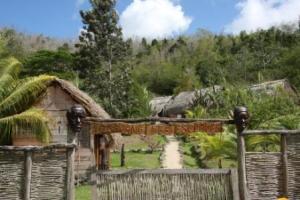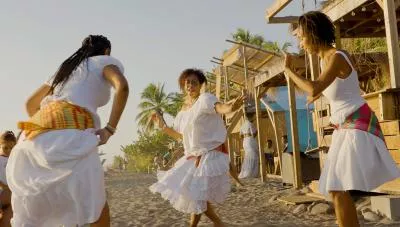Martinique invites you to follow in the footsteps of bèlè, a traditional Martinican art form combining dance, music, song and storytelling. So put on your ears and open your eyes wide, here comes the bèlè!

Songs, dances and tales: the bèlè

The bèlè in Martinique
Martinique invites you to follow in the footsteps of bèlè, a traditional Martinican art form combining dance, music, song and storytelling. So put on your ears and open your eyes wide, here comes the bèlè!
The origins of bèlè
Bèlè is an artistic practice that combines dance, rhythm, song and drumming. It's a traditional Martinican art form that has its roots in the dances and songs brought to Martinique by slaves. A true cultural expression used both as a means of resistance and a celebration of life. An ancestral and civilizational heritage of African culture and worship still present in Martinique.
In Martinique, bèlè evolved on sugar plantations and in rural communities as part of rituals linked to daily life or religious festivals. It then evolved in contact with European culture in the context of slavery, where it was forbidden to play.
It was then a way of giving rhythm to rural life. The songs, drums and dances of the bèlè were used to recount the history of the island or disputes between settlers. It's a way for the Martiniquais to talk about work, to tell the story, to talk about everyday life, but also about their social struggles. The bèlè song is an oral performance that holds society and the community together.
The word "bèlè" comes from "Bel air" in French, or the art of behaving well.
Among the emblematic artists bearing this Martinican musical tradition are Ti-Raoul and his Grivallier brothers, Ti-Emile, Sully Cally, or Eugene Mona and the Rastocle brothers.
The different bèlè of Martinique: shall we dance?
Bèlè is organized around a drum, a "voix douvan" singer, dancers and backup singers, also known as "voix dèyè". During a bèlè evening or moment, the organizer first addresses the dancers, who choose their tanbouyé, or drummer. It is the tanbouyé who then designates the solo singer with whom he or she will interact, before the latter selects the backing singers.
Lalin klè dances
"Lalin klè" or "moonlight" dances are celebrated under the full moon, when dancers and musicians gather to dance the bèlè. It's a powerful moment of sharing with ancestors and nature. Lalin klè celebrates fertility and harvest times.
The danmyé
The danmyé is a traditional combat dance, often associated with the bèlè, where the dancers' agility and cunning are put to the fore. It is accompanied by songs and drums, and symbolizes struggle, resistance and respect for ancestral values.
The bèlè repertoires
Repertoires vary depending on the region of Martinique. There are two types of bèlè in Martinique, the bèlè du Nord (or Bèlè Lino), very widely taught and spread across our beautiful island, and the bèlè du Sud (or Bèlè Lisid), less well known and practiced around Anses d'Arlet.
The bèlè drum
The bèlè drum is the central instrument in the world of bèlè. Handcrafted, it is traditionally composed of a hollowed tree trunk covered with goat or goat goat skin, carefully stretched and nailed.
The preparation of the skin is an art in itself: it is usually set to dry and then adjusted to obtain the ideal tension, in order to produce powerful, deep sounds. The bèlè drum is not just a musical instrument, it's also a strong cultural symbol of Martinican identity.
The tanbouyé (drummer) is an essential figure in bèlè performance. He embodies the "beating heart" of the dance and music. Much more than a simple accompanist, the tanbouyé guides the dance, following the movements of the lead dancer, the "débouya". The two observe and communicate in intense interaction: the drum's rhythmic variations mark key moments in the dance and link the dancers to the audience. The tanbouyé uses specific strokes to change tempo, emphasize a movement or even call the singer's attention. This ability to adapt, like a silent but expressive dialogue with the dancer, is a major part of the art and performance of bèlè.
L'oralité dans le bèlè
In bèlè, orality holds a central place: it's what makes it possible to transmit stories, songs and cultural values. The lyrics of bèlè songs, called "lavwa", are often improvised, echoing tales of daily life, stories of ancestors, or even committed messages. Lavwa" is performed by one or more singers, who sing rhythmic, repetitive melodies, alternating with backing vocals. The repetition of phrases and the "call and response" structure facilitate learning and audience engagement, particularly at community events where bèlè is practiced.
Bèlè songs perpetuate Martinique's oral history, telling stories of struggle, pride and resistance. Through this orality, bèlè transmits proverbs and life lessons, embodying the values and spirit of Martinique. This oral transmission is not set in stone: it evolves according to the experiences of each tanbouyé, singer or dancer, who enrich the repertoire with their own experiences.
A true symbiosis between dancers, musicians and audience, where everyone actively participates in the living transmission of our beautiful Martinican culture.
.The ti-bwa of bèlè
The ti-bwa (or "petit bois" in French) is another key bèlè instrument, although more discreet than the bèlè drum. Comprising two hardwood sticks, the ti-bwa is struck against the drum frame or on a specific wooden plank to create a counter-rhythm.
The ti-bwa plays a supporting role, adding nuances and maintaining a steady tempo, allowing the drum to lead the dance with more rhythmic freedom. The ti-bwa player, or tibwa-yé, creates repetitive rhythmic patterns that form the sound "framework" of the bèlè. This continuous rhythm acts as a base on which the tanbouyé and dancers can improvise. The dry, steady tones of the ti-bwa counterbalance the low, vibrant beats of the drum, creating a dynamic balance between power and subtlety.
Depending on the dances or styles of bèlè, the ti-bwa may adopt different rhythmic patterns. For example, in the more intense moments of the dance, the ti-bwa player may accelerate his tempo slightly, influencing the energy of the dance and prompting the tanbouyé to adapt his strikes. Experienced ti-bwa players know how to interpret the mood of a performance and adjust their playing to intensify the link between dancers, drum and song.
.Where to learn bèlè?
Bèlè associations in Martinique are important places where you can learn traditional songs, but also dance and play the bèlè drum. They are essential for the transmission of the ancestral art so important to Martinique that is bèlè.